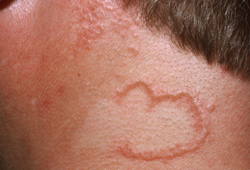Resumo
Definição
História e exame físico
Principais fatores diagnósticos
- pápulas dérmicas assintomáticas cor de pele ou rosa-forte agrupadas anularmente
Outros fatores diagnósticos
- máculas ou pápulas pequenas em cor de pele, rosa-forte ou marrom
- nódulos de tecidos moles
- pápulas perfurantes, lesões ulceradas ou com crostas
- manchas eritematosas
Fatores de risco
- diabetes mellitus
- neoplasia hematológica
- herpes-zóster
- vírus da imunodeficiência humana (HIV)
- hepatite
- hiperlipidemia
- doença tireoidiana
- medicações
Investigações diagnósticas
Primeiras investigações a serem solicitadas
- diagnóstico clínico
Investigações a serem consideradas
- biópsia de pele
- glicemia de jejum
- testes da função tireoidiana
- rastreamento lipídico
- rastreamento de hepatite
- teste de vírus da imunodeficiência humana (HIV)
Algoritmo de tratamento
variante localizada (erupção cutânea anular clássica)
variante generalizada (erupção cutânea macular disseminada)
variante perfurante (lesões com crostas ou ulceração)
variante subcutânea (nódulos macios)
variante tipo mancha (placas eritematosas)
Colaboradores
Autores
Misha Rosenbach, MD
Associate Professor
Dermatology and Internal Medicine
University of Pennsylvania
Philadelphia
PA
Declarações
MR has received consulting fees from Merck, aTyr Pharma, and Processa Pharma, not related to granuloma annulare. He has received grant support from Processa Pharma, not related to granuloma annulare. MR has received salary support from the AMA/JAMA for his role at JAMA Dermatology as Deputy Editor. MR is an author of references cited in this topic.
Agradecimentos
Dr Misha Rosenbach would like to gratefully acknowledge Dr Susmita Mukherjee, a previous contributor to this topic. SM declares that she has no competing interests.
Revisores
Aisha Sethi, MD
Assistant Professor of Medicine
Associate Residency Program Director
University of Chicago
Chicago
IL
Declarações
AS declares that she has no competing interests.
Robert Herd, MSc, MD, FRCP
Consultant Dermatologist
Department of Dermatology
Nuffield Hospital
Glasgow
UK
Declarações
RH declares that he has no competing interests.
Brenda L. Pellicane, MD
Dermatologist
Wayne State University School of Medicine
Department of Dermatology
Detroit
MI
Declarações
BLP declares that she has no competing interests.
Créditos aos pareceristas
Os tópicos do BMJ Best Practice são constantemente atualizados, seguindo os desenvolvimentos das evidências e das diretrizes. Os pareceristas aqui listados revisaram o conteúdo pelo menos uma vez durante a história do tópico.
Declarações
As afiliações e declarações dos pareceristas referem--se ao momento da revisão.
Referências
Principais artigos
Piette EW, Rosenbach M. Granuloma annulare: clinical and histologic variants, epidemiology, and genetics. J Am Acad Dermatol. 2016 Sep;75(3):457-65. Resumo
Thornsberry LA, English JC 3rd. Etiology, diagnosis, and therapeutic management of granuloma annulare: an update. Am J Clin Dermatol. 2013 Aug;14(4):279-90. Resumo
Piette EW, Rosenbach M. Granuloma annulare: pathogenesis, disease associations and triggers, and therapeutic options. J Am Acad Dermatol. 2016 Sep;75(3):467-79. Resumo
Artigos de referência
Uma lista completa das fontes referenciadas neste tópico está disponível para os usuários com acesso total ao BMJ Best Practice.

Diagnósticos diferenciais
- Líquen plano anular
- Infecções dermatofíticas
- Micose fungoide
Mais Diagnósticos diferenciaisConectar-se ou assinar para acessar todo o BMJ Best Practice
O uso deste conteúdo está sujeito ao nosso aviso legal